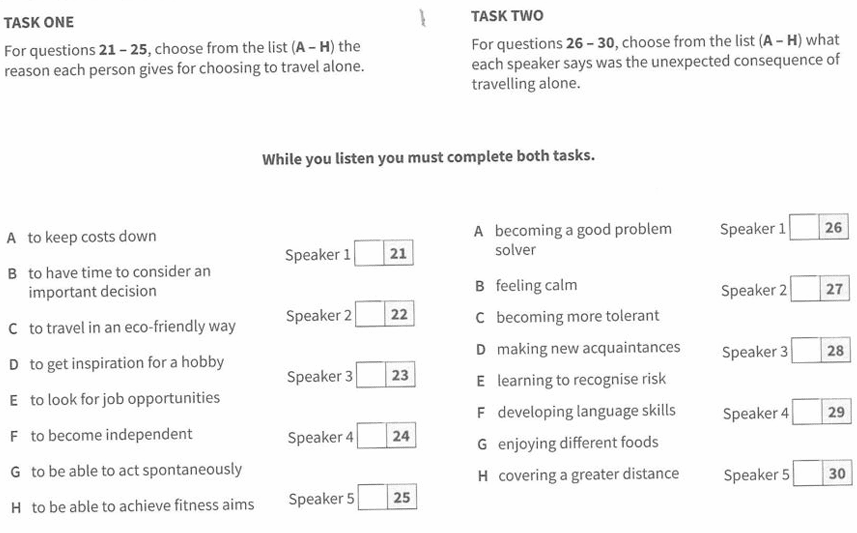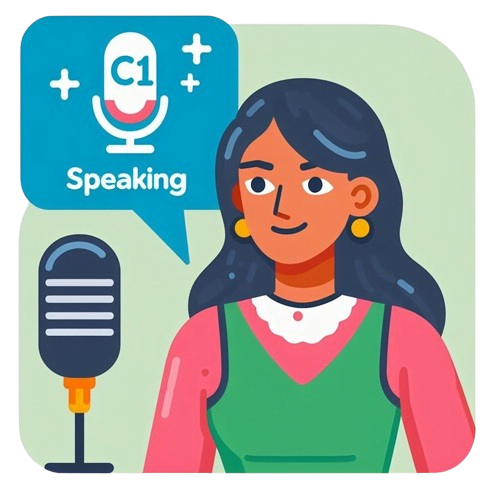Cambridge C1 Advanced (CAE) Listening Part 4
What you will find in this guide:
C1 Advanced (CAE) Listening Part 4
In C1 Listening Part 4 of the Cambridge C1 Advanced (CAE), you will get two listening tasks. You must listen to the track very carefully and do two matching tasks, matching the speaker to what he/she implied in the recording based on what you hear. Part 4 comprises a total of 10 questions. Questions 21 to 25 in task 1 and questions 26 to 30 in task 2. Each correct answer earns candidates 1 mark.
Sample Question
You will hear five short extracts in which people are talking about changing their jobs.
TASK ONE
For questions 21 – 25, choose from the list (A – H) the
reason each speaker gives for changing job.
TASK TWO
For questions 26 – 30, choose from the list (A – H) what each
speaker feels about their new job.
While you listen you must complete both tasks.
Audio
Task 1
A. unfriendly colleagues
B. poor holiday entitlement
C. lacking a sense of purpose
D. needing more of a challenge
E. the workload
F. disagreements with superiors
G. no prospect of advancement
H. the physical environment
Speaker 1 21
Speaker 2 22
Speaker 3 23
Speaker 4 24
Speaker 5 25
Task 2
A. encouraged by early results
B. hopeful about future success
C. delighted by a change in lifestyle
D. relieved the initial uncertainty is over
E. glad to be helping other people
F. grateful for an increase in salary
G. happy to feel in control
H. satisfied with the training received
Speaker 1 26
Speaker 2 27
Speaker 3 28
Speaker 4 29
Speaker 5 30
Potential Challenges in C1 Part 4
Part 1 of the Cambridge C1 Advanced (CAE) could be challenging due to the following factors:
- Accent: You may not be familiar with the accent of the people or one person speaking in the audio as they come from all over the world. To overcome this challenge, you need to expose yourself to listening audio tracks from different parts of the world as much as possible.
- Too Much Information: In this part, you will listen to people speaking about a topic and they will give you a lot of information. Processing all that information may be a bit difficult.
- Fast Delivery! This part involves a lot of information but also that information is delivered to you at the speed of light! So, you may miss some part of the information if you are not focused.
- Inferring and making decision about the correct choice: In this part, The speakers won’t speak about the topic asked in the question directly. In other words, the speaker won’t give you the answer as it is worded in the options. So, you have to infer from the information you listened to and draw a conclusion yourself. This could be tricky.
- Extra Options: The extra options provided in this part (5 speakers but 7 options) would make it a bit difficult to match the speaker to the idea presented in this part.
How to Answer the Questions in C1 (CAE) Listening Part 4
Step 1: Make sure to know what the task wants you to do.
Make sure that you understand what the task wants you to do and what the speakers are talking about. This helps you know what the speakers are talking about, which makes it easier to focus on what matters.
Step 2: Identify the keywords in each statement.
Keywords are the words that are most important or carry the most significant meaning in each answer choice or question. By identifying the keywords, you can quickly focus on what the statement is trying to say.
Step 3: Focus on the keywords as you listen to the audio.
Once you listen to the audio, listen for keywords you identified earlier. This way you won’t get lost in the audio. Once you hear the keyword or a synonym of it, focus on the meaning and try to figure out whether or not this statement related to what the speaker said.
Step 4: Use logic and reasoning skills to decide between two similar options.
It is often the case that two options seem to be correct. In these situations, you have to use your knowledge, what the speaker said and your reasoning skills to make a decision as to which statement relates to which speaker.
Note: Be very cautious of the synonyms and distractors. The audio introduces the ideas through synonyms so you have to be very diligent. Also, the speaker may use a word that seems to be the answer but later change the idea using a negative word that negates the idea introduced earlier. This is called a distractor, which you will regularly find in Cambridge listening tracks.
Advice: It may be a good idea to focus on task one when you listen to the recording for the first time and then cover task two when you listen to the recording for the second time. This way you can retain your focus.
Use the Guide
Now, use the guide to answer the following question:
You will hear five short extracts in which young people are talking about traveling alone.

How was your experience?
Describe your experience taking the part 4 listening question in the comment section below.
You may also check out my guides for the other parts of The Cambridge C1 Advanced (CAE) Listening Test:







The activities are difficult because we need to improve our listening, also, we need to learn find the keywords on the answers and find the keywords on the listening
This part is a really difficult task for me, but those steps helped me a lot to provide a reason to some questions
It is very good advice!
For me the part 4 was the most difficult part to understand and find the correct answer. However, I learnt some steps to deal with that questions.
The audio was difficult because of the length and also the variety of idioms that some of them were difficult to understand in the pronunciation and the speed of the way in which the speakers were talking.